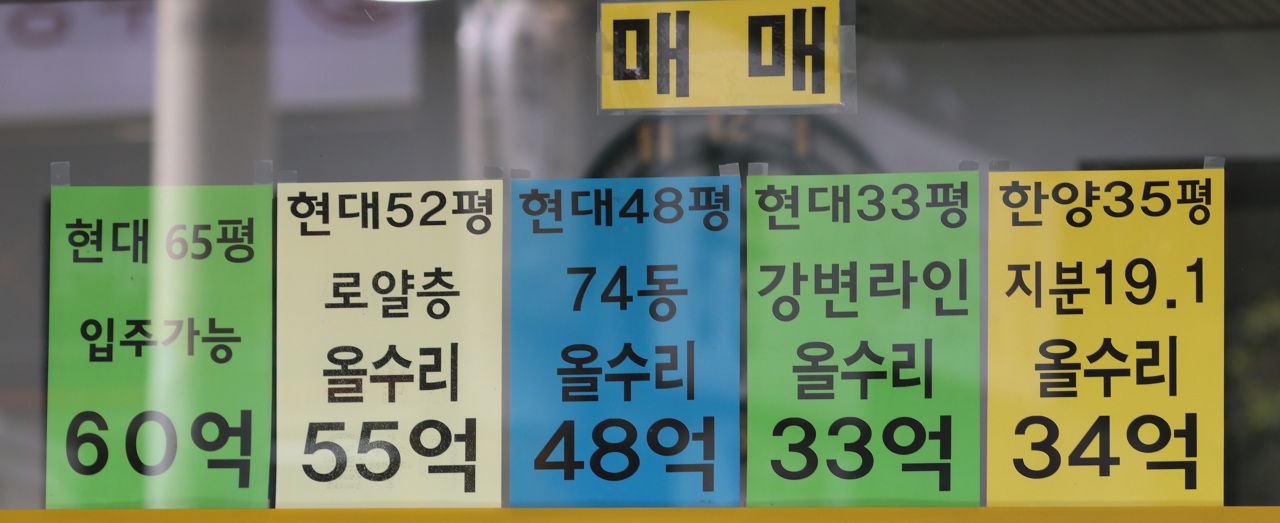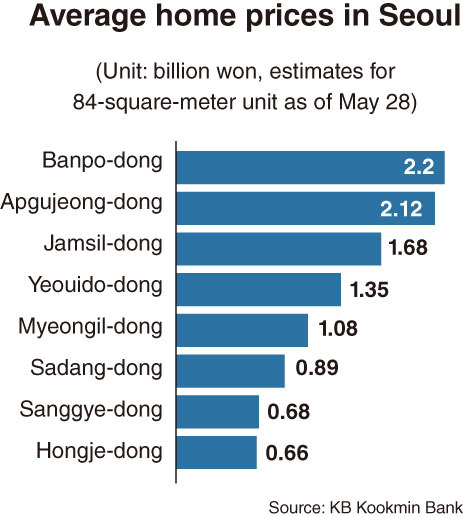[News Focus] Home prices in Seoul, Gyeonggi still rising despite curbs
Over 10% growth seen in Apgujeong, Banpo since Jan. 1
By Kim Yon-sePublished : June 1, 2021 - 16:40

SEJONG -- Recent housing prices in Apgujeong-dong, Seoul, suggest that a raft of real estate policies from the administration since 2017 to tamp down runaway property prices had little efficacy eventually.
According to KB Kookmin Bank and Naver.com, the average trading price of homes, including apartments, in Apgujeong-dong -- which belongs to Seoul’s Gangnam-gu -- surged by 11.4 percent for the first 21 weeks of this year.
Prices in the affluent district climbed to 83.58 million won ($75,300) per 3.3 square meters on May 28, from 75.01 million won on Jan. 1.
Banpo-dong, which is located in Seoul’s Secho-gu, posted a similar increase -- from 78.57 million won per 3.3 square meters to 86.55 million over the corresponding period, with the growth of average home prices reaching 10.1 percent in only five months.
Banpo-dong is drawing wide interest as the district has overtaken Gangnam’s Apgujeong-dong, a traditional luxury-apartment stronghold, in average prices in recent years.

The data for the fourth week of May means that the average price of an 84-square-meter home (a popular size in South Korea) in Apgujeong-dong and Banpo-dong would cost around 2.12 billion won and 2.2 billion won, respectively. A same-sized flat in an apartment building in the same locations is likely to cost more.
While other districts in Gangnam and Seocho-gu also posted a sharp growth, the same trend is also seen in Yeouido-dong, which belongs to Seoul’s Yeongdeungpo-gu. Yeouido-dong posted a 9.8 percent increase in home prices from 48.44 million won on Jan. 1 to 53.22 million on May 28.
Apgujeong-dong and Yeouido-dong are one of the few areas in the capital, where expectations for reconstruction of old apartments and redevelopment of land have been reflected. Reconstruction of apartments, built in the 1970s and 1980s, are underway in Banpo-dong.
Seoul Mayor Oh Se-hoon, who took office on April 8, has continued to express a strong resolution toward housing reconstruction and land redevelopment, since he was a candidate for the post.
Compared to a year ago on May 29, home prices in Apgujeong-dong, Banpo-dong and Yeouido-dong advanced by 25.5 percent, 16.6 percent and 19.9 percent, respectively.
While multiple homeowners will face heavier burden of capital gains taxes starting from this June, as the government had notified them of last year, the pace of growth for property prices in Seoul’s 25 wards (“gu”) has rather accelerated in May.
The KB Kookmin Bank data showed that average home prices of “only apartments” in the fourth week of May climbed by 0.35 percent from a week earlier. This marked the highest in 11 weeks on the basis of the on-week growth.
A growth of 0.63 percent was reported in Seocho-gu, 0.59 percent in Dongjak-gu, 0.58 percent in Nowon-gu, 0.54 percent in Dongdaemun-gu and 0.45 percent in Guro-gu.
The uptrend momentum spilled over to Gyeonggi Province and Incheon which saw the average growth in apartment prices in the fourth week of May outstrip the figure in the month’s third week.
Gyeonggi and Incheon posted 0.51 percent and 0.81 percent, respectively, compared to 0.38 percent and 0.62 percent a week earlier.
Over the past five months since Jan. 1, average home prices in Gyeonggi Province, including apartments, logged a growth of 29.6 percent in Yangju, 24.8 percent in Siheung and 21.7 percent in Uijeongbu.
Also in the province, Ilsandong-gu and Uiwang posted 16.7 percent and 16.4 percent in price advances over the corresponding 21 weeks.
By Kim Yon-se (kys@heraldcorp.com)







![[Graphic News] More Koreans say they plan long-distance trips this year](http://res.heraldm.com/phpwas/restmb_idxmake.php?idx=644&simg=/content/image/2024/04/17/20240417050828_0.gif&u=)
![[KH Explains] Hyundai's full hybrid edge to pay off amid slow transition to pure EVs](http://res.heraldm.com/phpwas/restmb_idxmake.php?idx=644&simg=/content/image/2024/04/18/20240418050645_0.jpg&u=20240419100350)





![[From the Scene] Monks, Buddhists hail return of remains of Buddhas](http://res.heraldm.com/phpwas/restmb_idxmake.php?idx=652&simg=/content/image/2024/04/19/20240419050617_0.jpg&u=20240419175937)

![[KH Explains] Hyundai's full hybrid edge to pay off amid slow transition to pure EVs](http://res.heraldm.com/phpwas/restmb_idxmake.php?idx=652&simg=/content/image/2024/04/18/20240418050645_0.jpg&u=20240419100350)

![[Today’s K-pop] Illit drops debut single remix](http://res.heraldm.com/phpwas/restmb_idxmake.php?idx=642&simg=/content/image/2024/04/19/20240419050612_0.jpg&u=)